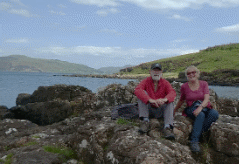 We have enjoyed some beautiful weather during much of
the past 3 weeks – so different to last summer’s rain, wind and cold. We have visited
some wonderful places, many in waters familiar to us from last year, constantly finding
ourselves comparing conditions this year and last. Almost invariably the general daily
weather forecasts have been for showers, but very frequently the reality has been sunny
and pleasant for a good part of most days and we have enjoyed numerous idyllic evenings
in the cockpit in stunning surroundings.
We have enjoyed some beautiful weather during much of
the past 3 weeks – so different to last summer’s rain, wind and cold. We have visited
some wonderful places, many in waters familiar to us from last year, constantly finding
ourselves comparing conditions this year and last. Almost invariably the general daily
weather forecasts have been for showers, but very frequently the reality has been sunny
and pleasant for a good part of most days and we have enjoyed numerous idyllic evenings
in the cockpit in stunning surroundings.
Our plan beyond Tobermory was more a list of desired locations, than a route…. Within
easy reach we had Coll and Tiree to the west, the Small Isles to the north, and Loch
Moidart and Loch Sunart on the mainland. Our stay in Tobermory was extended by a couple
of days due to strong winds – perfect for getting to several of our choices, but not for
anchoring when we got there. The Tiree Scottish Folk Music Festival that weekend had to
be cancelled due to strong winds and the inability of the Calmac Ferry to berth there,
validating our decision to stay put!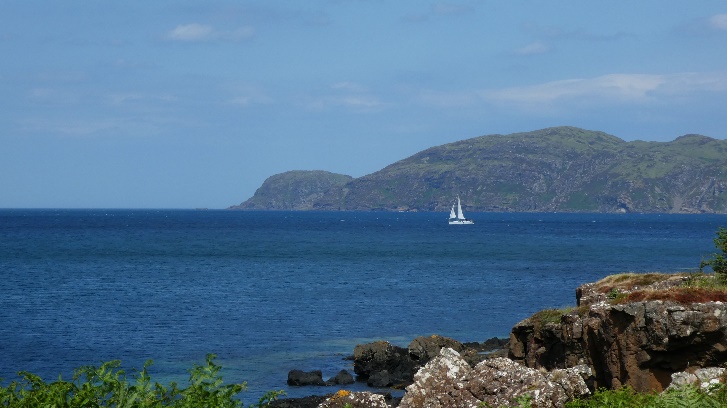 The miserable wet weather we had experienced over
the previous few days gave way to several bright days of sunshine, and while still too
windy to leave, we enjoyed a stunning walk out to Ardmore Bay at the north of Mull. The
route took us through vibrant pine forest and a profusion of wild-flowers – heather,
rosebay willow herb, thistles, clover, foxgloves - as Chris put it “Summer is getting
into its purple streak!” Reaching the coast we were rewarded with a perfect view of
Ardnamurchan Point – and just a couple of hardy yachts in a bright blue sea flecked with
whitecaps.
The miserable wet weather we had experienced over
the previous few days gave way to several bright days of sunshine, and while still too
windy to leave, we enjoyed a stunning walk out to Ardmore Bay at the north of Mull. The
route took us through vibrant pine forest and a profusion of wild-flowers – heather,
rosebay willow herb, thistles, clover, foxgloves - as Chris put it “Summer is getting
into its purple streak!” Reaching the coast we were rewarded with a perfect view of
Ardnamurchan Point – and just a couple of hardy yachts in a bright blue sea flecked with
whitecaps.
The following day we were off – in warm sunshine, but very little wind – along with a
flotilla of yachts escaping northwards from Tobermory, all heading for Ardnamurchan
Point – the westernmost tip of the UK mainland.  It was a memorable and beautiful trip.
Looking behind us up Loch Sunart was a typically Scottish view - folds of misty
mountains, and to the west were low lying Coll and Tiree. Approaching Ardnamurchan Point
– in very benign mode – opened the gateway to a new world, revealing first Muck, then
Rum, Eigg, Canna and Skye ahead of us. Also very acceptable were the 1 ½ knots of tide
under us – and even better was the sailing wind from about half way.
It was a memorable and beautiful trip.
Looking behind us up Loch Sunart was a typically Scottish view - folds of misty
mountains, and to the west were low lying Coll and Tiree. Approaching Ardnamurchan Point
– in very benign mode – opened the gateway to a new world, revealing first Muck, then
Rum, Eigg, Canna and Skye ahead of us. Also very acceptable were the 1 ½ knots of tide
under us – and even better was the sailing wind from about half way.
 The entry into Loch Moidart, weaving between rocks and islets was one of the most
tortuous we’ve ever done – a classic pilotage exercise. We were grateful for our
electronic aids! We anchored off a golden beach overlooked by the romantic ruins of
Tioram Castle on its own tidal island - an idyllic spot.
The entry into Loch Moidart, weaving between rocks and islets was one of the most
tortuous we’ve ever done – a classic pilotage exercise. We were grateful for our
electronic aids! We anchored off a golden beach overlooked by the romantic ruins of
Tioram Castle on its own tidal island - an idyllic spot.
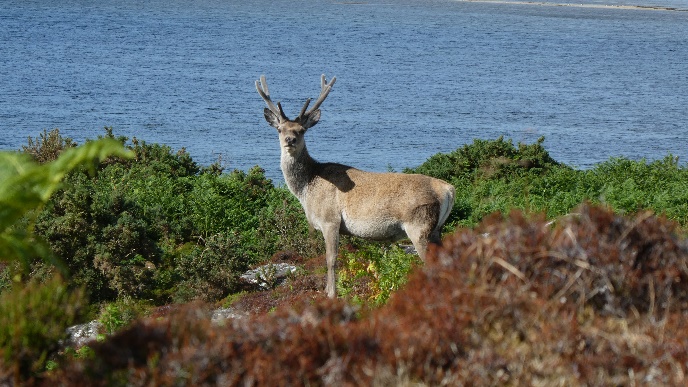
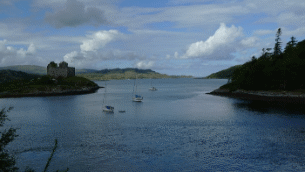 In yet more sunshine the next day we set off on a walk – and en route to the castle
almost immediately bumped into a stag, stopping to gaze at us completely unfazed! The
castle was built in the 13th century as an impenetrable stronghold and home to Clan
Ranald – but now an impenetrable ruin. The walk continued along the shore of Loch
Moidart along the ‘Silver Walk’ path built in the late 19th century, so named due to the
discovery of a hoard of Elizabethan coins during its construction, through stunningly
beautiful woodlands. On a couple of sections the path is cut out of the rocky cliffs.
This enchanting loch felt incredibly remote – just a couple of houses/lodges, and no
evidence of fishing activity – an extraordinarily beautiful place.
In yet more sunshine the next day we set off on a walk – and en route to the castle
almost immediately bumped into a stag, stopping to gaze at us completely unfazed! The
castle was built in the 13th century as an impenetrable stronghold and home to Clan
Ranald – but now an impenetrable ruin. The walk continued along the shore of Loch
Moidart along the ‘Silver Walk’ path built in the late 19th century, so named due to the
discovery of a hoard of Elizabethan coins during its construction, through stunningly
beautiful woodlands. On a couple of sections the path is cut out of the rocky cliffs.
This enchanting loch felt incredibly remote – just a couple of houses/lodges, and no
evidence of fishing activity – an extraordinarily beautiful place.
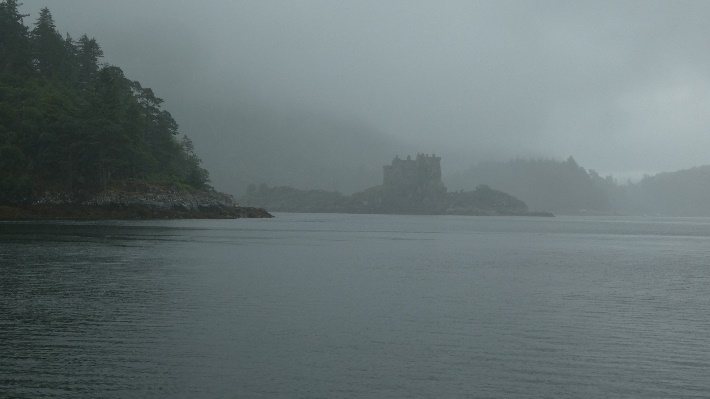 The following day saw a complete change of weather – with persistent drizzle and low
visibility. We pulled up the anchor with bated breath, having belatedly realised the
presence of underwater cables. Snagging the anchor in 9 metres depth would be a problem
- however, all was well! The views as we left the anchorage could best be described as
‘atmospheric’ – so different to our arrival in sunshine.
Having threaded our way back
out of Loch Moidart to open water, our destination, the island of Muck was barely
visible – though only about 10 miles across the water. It seemed to slip further into
the gloom as we approached, until suddenly emerging clear and green, if not exactly
sparkling. We anchored in the little harbour of Port Mor and as the sunshine was
re-instated we enjoyed a beautiful and unanticipated sunny evening in the cockpit,
gazing across to the Ardnamurchan Peninsula and lighthouse. Typical Scottish weather!
The following day saw a complete change of weather – with persistent drizzle and low
visibility. We pulled up the anchor with bated breath, having belatedly realised the
presence of underwater cables. Snagging the anchor in 9 metres depth would be a problem
- however, all was well! The views as we left the anchorage could best be described as
‘atmospheric’ – so different to our arrival in sunshine.
Having threaded our way back
out of Loch Moidart to open water, our destination, the island of Muck was barely
visible – though only about 10 miles across the water. It seemed to slip further into
the gloom as we approached, until suddenly emerging clear and green, if not exactly
sparkling. We anchored in the little harbour of Port Mor and as the sunshine was
re-instated we enjoyed a beautiful and unanticipated sunny evening in the cockpit,
gazing across to the Ardnamurchan Peninsula and lighthouse. Typical Scottish weather!
 Muck is the smallest of the Small Isles, roughly 2 ½ miles wide, with a scattered
population of 38. There is just one stretch of road 1 ½ miles long – visitors are not
permitted to bring cars. The island has no church, shop or post office but there is a
primary school for 6 children, a tearoom and gift shop. In 1896 after a series of
absentee owners, Muck came into the hands of the MacEwan family who have farmed the
island ever since, mainly livestock but also several small woods have been planted with
an eye to conserving and enhancing the environment for wildlife. We enjoyed a walk
through peaceful rural scenery to the spectacularly beautiful Gallanach Bay – a bright
white shell beach looking out across blue water to Canna, Rum and Eigg - before
‘conquering’ the island’s highest point - Beinn Airein, just 450’ - for surprisingly
extensive views as far as Iona – 30 miles south.
Muck is the smallest of the Small Isles, roughly 2 ½ miles wide, with a scattered
population of 38. There is just one stretch of road 1 ½ miles long – visitors are not
permitted to bring cars. The island has no church, shop or post office but there is a
primary school for 6 children, a tearoom and gift shop. In 1896 after a series of
absentee owners, Muck came into the hands of the MacEwan family who have farmed the
island ever since, mainly livestock but also several small woods have been planted with
an eye to conserving and enhancing the environment for wildlife. We enjoyed a walk
through peaceful rural scenery to the spectacularly beautiful Gallanach Bay – a bright
white shell beach looking out across blue water to Canna, Rum and Eigg - before
‘conquering’ the island’s highest point - Beinn Airein, just 450’ - for surprisingly
extensive views as far as Iona – 30 miles south.
 Next we moved on to Eigg – motoring the 5 miles in a glassy sea on another unexpected
day of sunshine. We were last on Eigg in 2009 for a brief lunch stop, and now wanted to
have a better look around the island. Julia was also there about 40 years ago during the
period when the island was owned by the eccentric and charismatic Keith Schellenberg –
businessman and ex-Winter Olympics competitor. A highlight of that holiday was
participating in the ‘Eigg Games’ – an event dreamed up by Schellenberg, between three
teams – the local inhabitants, a team from Muck and a visitors’ team (bizarrely named
the St Moritz Toboggan Team) which included a few holiday makers like ourselves and also
some of Schellenberg’s socialite friends including John Betjamin’s daughter! Eigg’s main
claim to fame is the community buy-out of the island in 1997 for £1.5 million, raised by
private donation – now considered a beacon of community ownership, replacing the feudal
style of ownership with sustainable, democratic administration. The island now has the
first completely wind, water and sun-powered electricity grid in the world. There is
also a community construction company which has built over 30 new homes and repaired
many others.
Next we moved on to Eigg – motoring the 5 miles in a glassy sea on another unexpected
day of sunshine. We were last on Eigg in 2009 for a brief lunch stop, and now wanted to
have a better look around the island. Julia was also there about 40 years ago during the
period when the island was owned by the eccentric and charismatic Keith Schellenberg –
businessman and ex-Winter Olympics competitor. A highlight of that holiday was
participating in the ‘Eigg Games’ – an event dreamed up by Schellenberg, between three
teams – the local inhabitants, a team from Muck and a visitors’ team (bizarrely named
the St Moritz Toboggan Team) which included a few holiday makers like ourselves and also
some of Schellenberg’s socialite friends including John Betjamin’s daughter! Eigg’s main
claim to fame is the community buy-out of the island in 1997 for £1.5 million, raised by
private donation – now considered a beacon of community ownership, replacing the feudal
style of ownership with sustainable, democratic administration. The island now has the
first completely wind, water and sun-powered electricity grid in the world. There is
also a community construction company which has built over 30 new homes and repaired
many others.
 We dinghied round to the harbour finding it buzzing with all sorts of activity,
including the Calmac ferry which had just arrived. The whole area is now completely
unrecognisable from that first visit to Eigg around 40 years ago with a huge new ferry
pier and excellent new building housing a café, shop, bike and canoe hire office, loos,
etc. We set off to walk across the island to the other main settlement and the ‘Singing
Sands’ beach. We accepted a lift of a couple of miles from Ruiri. Born and bred on Eigg,
he now works in Glasgow – back on a visit to his family – parents who run a restaurant
and brother who is building a home on a large plot of land. Ruiri has a static caravan
on another plot of land – his toe-hold on the island, which he would love to return to.
He remembers the days of Keith Schellenberg – “loved animals – a vegan before anyone
else thought of it - but hated people!” The ‘Singing Sands’ beach is stunningly scenic
with a view of Rum just across the water – and the sand - when stomped along does indeed
emit a squeaky sound!
We dinghied round to the harbour finding it buzzing with all sorts of activity,
including the Calmac ferry which had just arrived. The whole area is now completely
unrecognisable from that first visit to Eigg around 40 years ago with a huge new ferry
pier and excellent new building housing a café, shop, bike and canoe hire office, loos,
etc. We set off to walk across the island to the other main settlement and the ‘Singing
Sands’ beach. We accepted a lift of a couple of miles from Ruiri. Born and bred on Eigg,
he now works in Glasgow – back on a visit to his family – parents who run a restaurant
and brother who is building a home on a large plot of land. Ruiri has a static caravan
on another plot of land – his toe-hold on the island, which he would love to return to.
He remembers the days of Keith Schellenberg – “loved animals – a vegan before anyone
else thought of it - but hated people!” The ‘Singing Sands’ beach is stunningly scenic
with a view of Rum just across the water – and the sand - when stomped along does indeed
emit a squeaky sound!
Sadly we only had a day on Eigg. With bad weather in prospect we decided to hightail it
across to the port of Mallaig for better shelter and a pit-stop. The iconic profile of
Eigg disappeared in the gloom almost immediately as we set off on the 15 mile passage.
Checking with Mallaig marina en route it seemed we weren’t the only yacht heading their
way in anticipation of high winds. In the event, these did not materialise - curiously
we appeared to be right in the centre of a deep low crossing the UK, the pressure
dropping alarmingly in an uncanny calm. There was however plenty of rain! We just got on
with our boat cleaning, laundry, food shop, and minor repairs. Food shopping reminds us
that we’re in a foreign country – shelves of ‘beef lorn slices’ (rectangular patties of
mince), both black and white pudding, ‘skirlie’ (oatmeal, onion, suet mix used as
stuffing, or added to mashed potato) and of course abundant haggis.
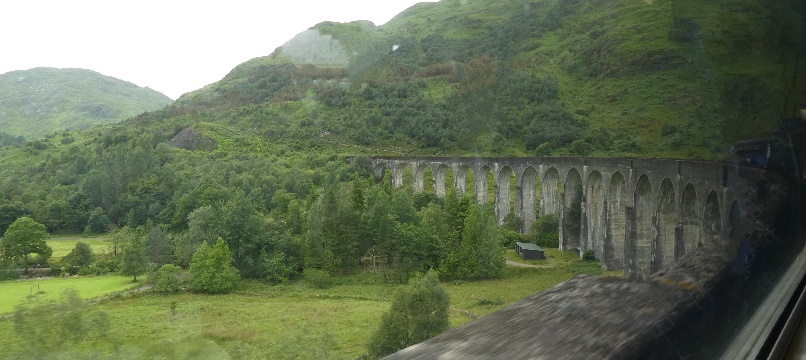 On our last day in Mallaig, in improving and dryer weather, we took a train ride to Fort
William on what is considered one of the UK’s most scenic railway journeys. This can be
done, at vast expense, on a steam train – both train and route featuring in the Harry
Potter films. We just used the ordinary ScotRail train and soon after crossing the
Glenfinnan Viaduct we alighted at Banavie, the stop before Fort William, to check out
‘Neptune’s Steps’ – the 8 lock flight at the start of the Caledonian Canal – as five
yachts were proceeding through.
On our last day in Mallaig, in improving and dryer weather, we took a train ride to Fort
William on what is considered one of the UK’s most scenic railway journeys. This can be
done, at vast expense, on a steam train – both train and route featuring in the Harry
Potter films. We just used the ordinary ScotRail train and soon after crossing the
Glenfinnan Viaduct we alighted at Banavie, the stop before Fort William, to check out
‘Neptune’s Steps’ – the 8 lock flight at the start of the Caledonian Canal – as five
yachts were proceeding through. 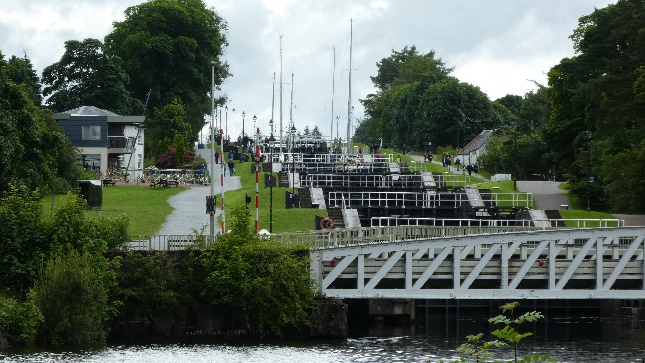 Fascinating to observe – just in case we should want to
do it ourselves at some point. Apparently the canal, opened in 1822, was conceived by
Thomas Telford as one of several measures which might stem emigration from the Highlands
- the construction of public works providing employment, and also a help to develop
industry, fishery and agriculture.
Fascinating to observe – just in case we should want to
do it ourselves at some point. Apparently the canal, opened in 1822, was conceived by
Thomas Telford as one of several measures which might stem emigration from the Highlands
- the construction of public works providing employment, and also a help to develop
industry, fishery and agriculture.
From Mallaig we continued our trip northwards. First, keen to get back to our
exploration of the deep lochs of the mainland, we headed into Loch Hourn. Last year, the
entrance to this loch, opposite Isle Ornsay on Skye where we waited out a gale, appeared
deeply ominous.
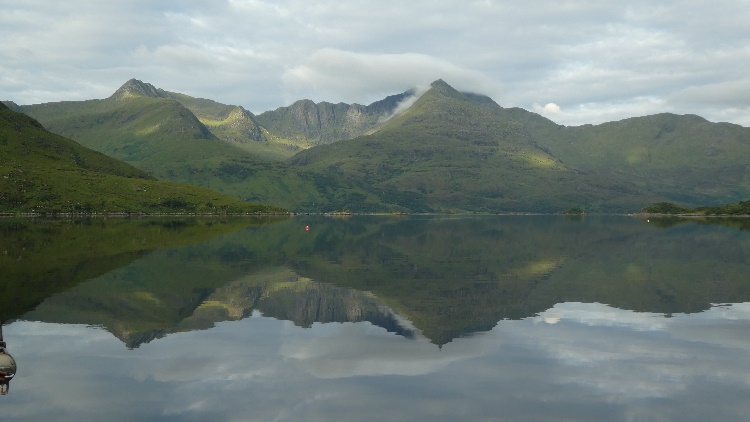 According to the pilot, Loch Hourn is “one of the most spectacular lochs
in Scotland but subject to very high rainfall and severe squalls generated by the high
mountains surrounding it. It is extremely wild and remote and is best seen on a dark day
with the cloud streaming off the mountains.” Our entrance was in bright, clear sunny
weather – but even so, surrounded by the spectacular mighty rugged mountains it looked
quite forbidding – a serious place. We ventured just over half the 14 mile length of the
loch, anchoring just short of second set of narrows, alone among the awe-inspiring peaks
with very little sign of human habitation - intrigued by a number of tiny springs
bubbling up creating mini fountains on the shore close by. We woke the next morning to a
glassy calm watching the loch gradually come to life as the sun arrived and a light
breeze picked up. When the tide started ebbing, we progressed back out of the loch which
was beginning to look more brooding in increasingly overcast conditions. The Sandaig
islands in the Sound of Sleat, where we next anchored, (where Gavin Maxwell wrote ‘Ring
of Bright Water’) were small scale and pretty, in complete contrast.
According to the pilot, Loch Hourn is “one of the most spectacular lochs
in Scotland but subject to very high rainfall and severe squalls generated by the high
mountains surrounding it. It is extremely wild and remote and is best seen on a dark day
with the cloud streaming off the mountains.” Our entrance was in bright, clear sunny
weather – but even so, surrounded by the spectacular mighty rugged mountains it looked
quite forbidding – a serious place. We ventured just over half the 14 mile length of the
loch, anchoring just short of second set of narrows, alone among the awe-inspiring peaks
with very little sign of human habitation - intrigued by a number of tiny springs
bubbling up creating mini fountains on the shore close by. We woke the next morning to a
glassy calm watching the loch gradually come to life as the sun arrived and a light
breeze picked up. When the tide started ebbing, we progressed back out of the loch which
was beginning to look more brooding in increasingly overcast conditions. The Sandaig
islands in the Sound of Sleat, where we next anchored, (where Gavin Maxwell wrote ‘Ring
of Bright Water’) were small scale and pretty, in complete contrast.
 The following day we woke early to move on, our next passage involving two tidal gates.
First was Kyle Rhea, the narrow passage between the Sound of Sleat and Loch Alsh.
Accompanied by a series of solitary seals popping heads up beside us, we reached the
entrance with a satisfying 4 knots under us. We were quickly through and after an hour
reached the Skye Bridge – and a new tidal regime – also timed to perfection! We then
turned into waters new to us to head north up the Inner Sound, between the mainland
coast and the long narrow islands of Raasay and Rona lying off the east coast of Skye.
The following day we woke early to move on, our next passage involving two tidal gates.
First was Kyle Rhea, the narrow passage between the Sound of Sleat and Loch Alsh.
Accompanied by a series of solitary seals popping heads up beside us, we reached the
entrance with a satisfying 4 knots under us. We were quickly through and after an hour
reached the Skye Bridge – and a new tidal regime – also timed to perfection! We then
turned into waters new to us to head north up the Inner Sound, between the mainland
coast and the long narrow islands of Raasay and Rona lying off the east coast of Skye.
After about an hour and a half we turned into Loch Carron and picked up a visitors’ buoy
in Plockton – and the sun came out!
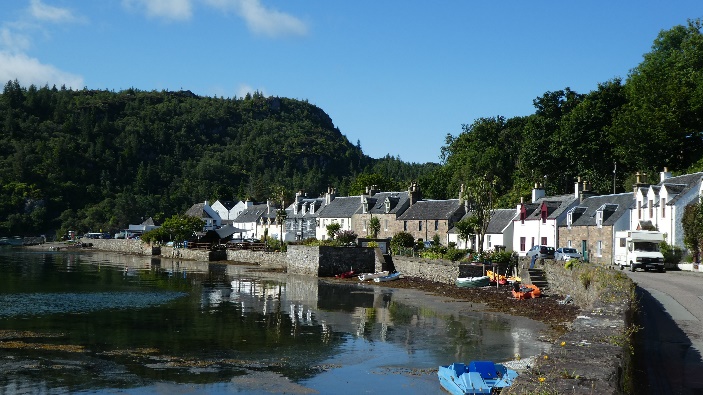 The village is one of the most enchanting and
picturesque we’ve visited with rows of pretty white cottages, gardens abundant with
flowers and, with its very mild climate, an almost tropical feel with numerous cabbage
tree palms. With its beautiful scenic views out into the bay it is perfection. The
village was planned and created in the early 1800s as a fishing village to provide a new
living for evicted crofters. Thomas Telford – who got everywhere - designed the Parish
Church and some of the houses in the village.
The village is one of the most enchanting and
picturesque we’ve visited with rows of pretty white cottages, gardens abundant with
flowers and, with its very mild climate, an almost tropical feel with numerous cabbage
tree palms. With its beautiful scenic views out into the bay it is perfection. The
village was planned and created in the early 1800s as a fishing village to provide a new
living for evicted crofters. Thomas Telford – who got everywhere - designed the Parish
Church and some of the houses in the village.  Due to continuing clearances in the wider
area, the population increased with herring fishing underpinning the local economy.
After several economic ups and downs, and with better roads and communications, tourism
grew, becoming the main economic activity. The whole promontory also supports a thriving
crofting community. The renowned Gaelic and socialist poet Somhairle MacGill-Eain
(Sorley MacLean) was headmaster of the local school from 1956 to 1972, strongly
promoting the teaching of Gaelic in schools.
Due to continuing clearances in the wider
area, the population increased with herring fishing underpinning the local economy.
After several economic ups and downs, and with better roads and communications, tourism
grew, becoming the main economic activity. The whole promontory also supports a thriving
crofting community. The renowned Gaelic and socialist poet Somhairle MacGill-Eain
(Sorley MacLean) was headmaster of the local school from 1956 to 1972, strongly
promoting the teaching of Gaelic in schools.
 While in Plockton we enjoyed a couple of delightful walks – the first around the bay to
Duncraig Castle built in 1853, in typical Scottish Baronial style, by the estate owner
‘on crofters’ common grazing land’. It seems to have enjoyed a remarkable variety of
uses and owners – its current ownership is unknown, but appeared mysteriously private
and not welcome to visitors…. Stronger winds arrived on the day of a small regatta for
cruising boats which rather alarmingly warmed up by tacking through the moorings. We
walked to a western cove with a coral (ie shelly) beach with stunning views over to Skye
– and of the well heeled boats returning. Sadly the evening dinghy racing had to be
abandoned.
While in Plockton we enjoyed a couple of delightful walks – the first around the bay to
Duncraig Castle built in 1853, in typical Scottish Baronial style, by the estate owner
‘on crofters’ common grazing land’. It seems to have enjoyed a remarkable variety of
uses and owners – its current ownership is unknown, but appeared mysteriously private
and not welcome to visitors…. Stronger winds arrived on the day of a small regatta for
cruising boats which rather alarmingly warmed up by tacking through the moorings. We
walked to a western cove with a coral (ie shelly) beach with stunning views over to Skye
– and of the well heeled boats returning. Sadly the evening dinghy racing had to be
abandoned.
Our next passage, northwards to Loch Torridon, was enlivened when we spotted a submarine
and then overheard VHF communications between a Kyle of Lochalsh tug and ‘Surface
Submarine’ – a US warship. The Range Boat for the nearby submarine exercise area then
called us up to confirm the area was in use and to request that we hug close to the
coast for our passage up the Inner Sound. The submarine disappeared from sight and the
rest of the passage was disappointingly uneventful, in heavy cloud and adverse winds
with rather sombre views all around - the Red Cuillins behind us, the distinctive
northern tip of Skye to the west and further out the faint shapes of Lewis and Harris –
and the Shiants. Loch Torridon, as we turned into it, looked atmospheric to say the
least – somewhere the sun doesn’t shine!
 How wrong we were! We woke the next morning to a clear blue sky and flat calm. Time to
plan our next phase - to decide how far to continue north before needing to head ‘home’.
We may now have reached our limit – as soon as any northerlies set in we’ll be off
south. In the meantime Loch Torridon now looks very enticing!
How wrong we were! We woke the next morning to a clear blue sky and flat calm. Time to
plan our next phase - to decide how far to continue north before needing to head ‘home’.
We may now have reached our limit – as soon as any northerlies set in we’ll be off
south. In the meantime Loch Torridon now looks very enticing!
Julia, Chris and Aremiti
 We have enjoyed some beautiful weather during much of
the past 3 weeks – so different to last summer’s rain, wind and cold. We have visited
some wonderful places, many in waters familiar to us from last year, constantly finding
ourselves comparing conditions this year and last. Almost invariably the general daily
weather forecasts have been for showers, but very frequently the reality has been sunny
and pleasant for a good part of most days and we have enjoyed numerous idyllic evenings
in the cockpit in stunning surroundings.
We have enjoyed some beautiful weather during much of
the past 3 weeks – so different to last summer’s rain, wind and cold. We have visited
some wonderful places, many in waters familiar to us from last year, constantly finding
ourselves comparing conditions this year and last. Almost invariably the general daily
weather forecasts have been for showers, but very frequently the reality has been sunny
and pleasant for a good part of most days and we have enjoyed numerous idyllic evenings
in the cockpit in stunning surroundings.  The miserable wet weather we had experienced over
the previous few days gave way to several bright days of sunshine, and while still too
windy to leave, we enjoyed a stunning walk out to Ardmore Bay at the north of Mull. The
route took us through vibrant pine forest and a profusion of wild-flowers – heather,
rosebay willow herb, thistles, clover, foxgloves - as Chris put it “Summer is getting
into its purple streak!” Reaching the coast we were rewarded with a perfect view of
Ardnamurchan Point – and just a couple of hardy yachts in a bright blue sea flecked with
whitecaps.
The miserable wet weather we had experienced over
the previous few days gave way to several bright days of sunshine, and while still too
windy to leave, we enjoyed a stunning walk out to Ardmore Bay at the north of Mull. The
route took us through vibrant pine forest and a profusion of wild-flowers – heather,
rosebay willow herb, thistles, clover, foxgloves - as Chris put it “Summer is getting
into its purple streak!” Reaching the coast we were rewarded with a perfect view of
Ardnamurchan Point – and just a couple of hardy yachts in a bright blue sea flecked with
whitecaps.  It was a memorable and beautiful trip.
Looking behind us up Loch Sunart was a typically Scottish view - folds of misty
mountains, and to the west were low lying Coll and Tiree. Approaching Ardnamurchan Point
– in very benign mode – opened the gateway to a new world, revealing first Muck, then
Rum, Eigg, Canna and Skye ahead of us. Also very acceptable were the 1 ½ knots of tide
under us – and even better was the sailing wind from about half way.
It was a memorable and beautiful trip.
Looking behind us up Loch Sunart was a typically Scottish view - folds of misty
mountains, and to the west were low lying Coll and Tiree. Approaching Ardnamurchan Point
– in very benign mode – opened the gateway to a new world, revealing first Muck, then
Rum, Eigg, Canna and Skye ahead of us. Also very acceptable were the 1 ½ knots of tide
under us – and even better was the sailing wind from about half way.  The entry into Loch Moidart, weaving between rocks and islets was one of the most
tortuous we’ve ever done – a classic pilotage exercise. We were grateful for our
electronic aids! We anchored off a golden beach overlooked by the romantic ruins of
Tioram Castle on its own tidal island - an idyllic spot.
The entry into Loch Moidart, weaving between rocks and islets was one of the most
tortuous we’ve ever done – a classic pilotage exercise. We were grateful for our
electronic aids! We anchored off a golden beach overlooked by the romantic ruins of
Tioram Castle on its own tidal island - an idyllic spot. 
 In yet more sunshine the next day we set off on a walk – and en route to the castle
almost immediately bumped into a stag, stopping to gaze at us completely unfazed! The
castle was built in the 13th century as an impenetrable stronghold and home to Clan
Ranald – but now an impenetrable ruin. The walk continued along the shore of Loch
Moidart along the ‘Silver Walk’ path built in the late 19th century, so named due to the
discovery of a hoard of Elizabethan coins during its construction, through stunningly
beautiful woodlands. On a couple of sections the path is cut out of the rocky cliffs.
This enchanting loch felt incredibly remote – just a couple of houses/lodges, and no
evidence of fishing activity – an extraordinarily beautiful place.
In yet more sunshine the next day we set off on a walk – and en route to the castle
almost immediately bumped into a stag, stopping to gaze at us completely unfazed! The
castle was built in the 13th century as an impenetrable stronghold and home to Clan
Ranald – but now an impenetrable ruin. The walk continued along the shore of Loch
Moidart along the ‘Silver Walk’ path built in the late 19th century, so named due to the
discovery of a hoard of Elizabethan coins during its construction, through stunningly
beautiful woodlands. On a couple of sections the path is cut out of the rocky cliffs.
This enchanting loch felt incredibly remote – just a couple of houses/lodges, and no
evidence of fishing activity – an extraordinarily beautiful place.  The following day saw a complete change of weather – with persistent drizzle and low
visibility. We pulled up the anchor with bated breath, having belatedly realised the
presence of underwater cables. Snagging the anchor in 9 metres depth would be a problem
- however, all was well! The views as we left the anchorage could best be described as
‘atmospheric’ – so different to our arrival in sunshine.
Having threaded our way back
out of Loch Moidart to open water, our destination, the island of Muck was barely
visible – though only about 10 miles across the water. It seemed to slip further into
the gloom as we approached, until suddenly emerging clear and green, if not exactly
sparkling. We anchored in the little harbour of Port Mor and as the sunshine was
re-instated we enjoyed a beautiful and unanticipated sunny evening in the cockpit,
gazing across to the Ardnamurchan Peninsula and lighthouse. Typical Scottish weather!
The following day saw a complete change of weather – with persistent drizzle and low
visibility. We pulled up the anchor with bated breath, having belatedly realised the
presence of underwater cables. Snagging the anchor in 9 metres depth would be a problem
- however, all was well! The views as we left the anchorage could best be described as
‘atmospheric’ – so different to our arrival in sunshine.
Having threaded our way back
out of Loch Moidart to open water, our destination, the island of Muck was barely
visible – though only about 10 miles across the water. It seemed to slip further into
the gloom as we approached, until suddenly emerging clear and green, if not exactly
sparkling. We anchored in the little harbour of Port Mor and as the sunshine was
re-instated we enjoyed a beautiful and unanticipated sunny evening in the cockpit,
gazing across to the Ardnamurchan Peninsula and lighthouse. Typical Scottish weather!  Muck is the smallest of the Small Isles, roughly 2 ½ miles wide, with a scattered
population of 38. There is just one stretch of road 1 ½ miles long – visitors are not
permitted to bring cars. The island has no church, shop or post office but there is a
primary school for 6 children, a tearoom and gift shop. In 1896 after a series of
absentee owners, Muck came into the hands of the MacEwan family who have farmed the
island ever since, mainly livestock but also several small woods have been planted with
an eye to conserving and enhancing the environment for wildlife. We enjoyed a walk
through peaceful rural scenery to the spectacularly beautiful Gallanach Bay – a bright
white shell beach looking out across blue water to Canna, Rum and Eigg - before
‘conquering’ the island’s highest point - Beinn Airein, just 450’ - for surprisingly
extensive views as far as Iona – 30 miles south.
Muck is the smallest of the Small Isles, roughly 2 ½ miles wide, with a scattered
population of 38. There is just one stretch of road 1 ½ miles long – visitors are not
permitted to bring cars. The island has no church, shop or post office but there is a
primary school for 6 children, a tearoom and gift shop. In 1896 after a series of
absentee owners, Muck came into the hands of the MacEwan family who have farmed the
island ever since, mainly livestock but also several small woods have been planted with
an eye to conserving and enhancing the environment for wildlife. We enjoyed a walk
through peaceful rural scenery to the spectacularly beautiful Gallanach Bay – a bright
white shell beach looking out across blue water to Canna, Rum and Eigg - before
‘conquering’ the island’s highest point - Beinn Airein, just 450’ - for surprisingly
extensive views as far as Iona – 30 miles south.  Next we moved on to Eigg – motoring the 5 miles in a glassy sea on another unexpected
day of sunshine. We were last on Eigg in 2009 for a brief lunch stop, and now wanted to
have a better look around the island. Julia was also there about 40 years ago during the
period when the island was owned by the eccentric and charismatic Keith Schellenberg –
businessman and ex-Winter Olympics competitor. A highlight of that holiday was
participating in the ‘Eigg Games’ – an event dreamed up by Schellenberg, between three
teams – the local inhabitants, a team from Muck and a visitors’ team (bizarrely named
the St Moritz Toboggan Team) which included a few holiday makers like ourselves and also
some of Schellenberg’s socialite friends including John Betjamin’s daughter! Eigg’s main
claim to fame is the community buy-out of the island in 1997 for £1.5 million, raised by
private donation – now considered a beacon of community ownership, replacing the feudal
style of ownership with sustainable, democratic administration. The island now has the
first completely wind, water and sun-powered electricity grid in the world. There is
also a community construction company which has built over 30 new homes and repaired
many others.
Next we moved on to Eigg – motoring the 5 miles in a glassy sea on another unexpected
day of sunshine. We were last on Eigg in 2009 for a brief lunch stop, and now wanted to
have a better look around the island. Julia was also there about 40 years ago during the
period when the island was owned by the eccentric and charismatic Keith Schellenberg –
businessman and ex-Winter Olympics competitor. A highlight of that holiday was
participating in the ‘Eigg Games’ – an event dreamed up by Schellenberg, between three
teams – the local inhabitants, a team from Muck and a visitors’ team (bizarrely named
the St Moritz Toboggan Team) which included a few holiday makers like ourselves and also
some of Schellenberg’s socialite friends including John Betjamin’s daughter! Eigg’s main
claim to fame is the community buy-out of the island in 1997 for £1.5 million, raised by
private donation – now considered a beacon of community ownership, replacing the feudal
style of ownership with sustainable, democratic administration. The island now has the
first completely wind, water and sun-powered electricity grid in the world. There is
also a community construction company which has built over 30 new homes and repaired
many others.  We dinghied round to the harbour finding it buzzing with all sorts of activity,
including the Calmac ferry which had just arrived. The whole area is now completely
unrecognisable from that first visit to Eigg around 40 years ago with a huge new ferry
pier and excellent new building housing a café, shop, bike and canoe hire office, loos,
etc. We set off to walk across the island to the other main settlement and the ‘Singing
Sands’ beach. We accepted a lift of a couple of miles from Ruiri. Born and bred on Eigg,
he now works in Glasgow – back on a visit to his family – parents who run a restaurant
and brother who is building a home on a large plot of land. Ruiri has a static caravan
on another plot of land – his toe-hold on the island, which he would love to return to.
He remembers the days of Keith Schellenberg – “loved animals – a vegan before anyone
else thought of it - but hated people!” The ‘Singing Sands’ beach is stunningly scenic
with a view of Rum just across the water – and the sand - when stomped along does indeed
emit a squeaky sound!
We dinghied round to the harbour finding it buzzing with all sorts of activity,
including the Calmac ferry which had just arrived. The whole area is now completely
unrecognisable from that first visit to Eigg around 40 years ago with a huge new ferry
pier and excellent new building housing a café, shop, bike and canoe hire office, loos,
etc. We set off to walk across the island to the other main settlement and the ‘Singing
Sands’ beach. We accepted a lift of a couple of miles from Ruiri. Born and bred on Eigg,
he now works in Glasgow – back on a visit to his family – parents who run a restaurant
and brother who is building a home on a large plot of land. Ruiri has a static caravan
on another plot of land – his toe-hold on the island, which he would love to return to.
He remembers the days of Keith Schellenberg – “loved animals – a vegan before anyone
else thought of it - but hated people!” The ‘Singing Sands’ beach is stunningly scenic
with a view of Rum just across the water – and the sand - when stomped along does indeed
emit a squeaky sound!  On our last day in Mallaig, in improving and dryer weather, we took a train ride to Fort
William on what is considered one of the UK’s most scenic railway journeys. This can be
done, at vast expense, on a steam train – both train and route featuring in the Harry
Potter films. We just used the ordinary ScotRail train and soon after crossing the
Glenfinnan Viaduct we alighted at Banavie, the stop before Fort William, to check out
‘Neptune’s Steps’ – the 8 lock flight at the start of the Caledonian Canal – as five
yachts were proceeding through.
On our last day in Mallaig, in improving and dryer weather, we took a train ride to Fort
William on what is considered one of the UK’s most scenic railway journeys. This can be
done, at vast expense, on a steam train – both train and route featuring in the Harry
Potter films. We just used the ordinary ScotRail train and soon after crossing the
Glenfinnan Viaduct we alighted at Banavie, the stop before Fort William, to check out
‘Neptune’s Steps’ – the 8 lock flight at the start of the Caledonian Canal – as five
yachts were proceeding through.  Fascinating to observe – just in case we should want to
do it ourselves at some point. Apparently the canal, opened in 1822, was conceived by
Thomas Telford as one of several measures which might stem emigration from the Highlands
- the construction of public works providing employment, and also a help to develop
industry, fishery and agriculture.
Fascinating to observe – just in case we should want to
do it ourselves at some point. Apparently the canal, opened in 1822, was conceived by
Thomas Telford as one of several measures which might stem emigration from the Highlands
- the construction of public works providing employment, and also a help to develop
industry, fishery and agriculture.  According to the pilot, Loch Hourn is “one of the most spectacular lochs
in Scotland but subject to very high rainfall and severe squalls generated by the high
mountains surrounding it. It is extremely wild and remote and is best seen on a dark day
with the cloud streaming off the mountains.” Our entrance was in bright, clear sunny
weather – but even so, surrounded by the spectacular mighty rugged mountains it looked
quite forbidding – a serious place. We ventured just over half the 14 mile length of the
loch, anchoring just short of second set of narrows, alone among the awe-inspiring peaks
with very little sign of human habitation - intrigued by a number of tiny springs
bubbling up creating mini fountains on the shore close by. We woke the next morning to a
glassy calm watching the loch gradually come to life as the sun arrived and a light
breeze picked up. When the tide started ebbing, we progressed back out of the loch which
was beginning to look more brooding in increasingly overcast conditions. The Sandaig
islands in the Sound of Sleat, where we next anchored, (where Gavin Maxwell wrote ‘Ring
of Bright Water’) were small scale and pretty, in complete contrast.
According to the pilot, Loch Hourn is “one of the most spectacular lochs
in Scotland but subject to very high rainfall and severe squalls generated by the high
mountains surrounding it. It is extremely wild and remote and is best seen on a dark day
with the cloud streaming off the mountains.” Our entrance was in bright, clear sunny
weather – but even so, surrounded by the spectacular mighty rugged mountains it looked
quite forbidding – a serious place. We ventured just over half the 14 mile length of the
loch, anchoring just short of second set of narrows, alone among the awe-inspiring peaks
with very little sign of human habitation - intrigued by a number of tiny springs
bubbling up creating mini fountains on the shore close by. We woke the next morning to a
glassy calm watching the loch gradually come to life as the sun arrived and a light
breeze picked up. When the tide started ebbing, we progressed back out of the loch which
was beginning to look more brooding in increasingly overcast conditions. The Sandaig
islands in the Sound of Sleat, where we next anchored, (where Gavin Maxwell wrote ‘Ring
of Bright Water’) were small scale and pretty, in complete contrast.  The following day we woke early to move on, our next passage involving two tidal gates.
First was Kyle Rhea, the narrow passage between the Sound of Sleat and Loch Alsh.
Accompanied by a series of solitary seals popping heads up beside us, we reached the
entrance with a satisfying 4 knots under us. We were quickly through and after an hour
reached the Skye Bridge – and a new tidal regime – also timed to perfection! We then
turned into waters new to us to head north up the Inner Sound, between the mainland
coast and the long narrow islands of Raasay and Rona lying off the east coast of Skye.
The following day we woke early to move on, our next passage involving two tidal gates.
First was Kyle Rhea, the narrow passage between the Sound of Sleat and Loch Alsh.
Accompanied by a series of solitary seals popping heads up beside us, we reached the
entrance with a satisfying 4 knots under us. We were quickly through and after an hour
reached the Skye Bridge – and a new tidal regime – also timed to perfection! We then
turned into waters new to us to head north up the Inner Sound, between the mainland
coast and the long narrow islands of Raasay and Rona lying off the east coast of Skye.
 The village is one of the most enchanting and
picturesque we’ve visited with rows of pretty white cottages, gardens abundant with
flowers and, with its very mild climate, an almost tropical feel with numerous cabbage
tree palms. With its beautiful scenic views out into the bay it is perfection. The
village was planned and created in the early 1800s as a fishing village to provide a new
living for evicted crofters. Thomas Telford – who got everywhere - designed the Parish
Church and some of the houses in the village.
The village is one of the most enchanting and
picturesque we’ve visited with rows of pretty white cottages, gardens abundant with
flowers and, with its very mild climate, an almost tropical feel with numerous cabbage
tree palms. With its beautiful scenic views out into the bay it is perfection. The
village was planned and created in the early 1800s as a fishing village to provide a new
living for evicted crofters. Thomas Telford – who got everywhere - designed the Parish
Church and some of the houses in the village.  Due to continuing clearances in the wider
area, the population increased with herring fishing underpinning the local economy.
After several economic ups and downs, and with better roads and communications, tourism
grew, becoming the main economic activity. The whole promontory also supports a thriving
crofting community. The renowned Gaelic and socialist poet Somhairle MacGill-Eain
(Sorley MacLean) was headmaster of the local school from 1956 to 1972, strongly
promoting the teaching of Gaelic in schools.
Due to continuing clearances in the wider
area, the population increased with herring fishing underpinning the local economy.
After several economic ups and downs, and with better roads and communications, tourism
grew, becoming the main economic activity. The whole promontory also supports a thriving
crofting community. The renowned Gaelic and socialist poet Somhairle MacGill-Eain
(Sorley MacLean) was headmaster of the local school from 1956 to 1972, strongly
promoting the teaching of Gaelic in schools.  While in Plockton we enjoyed a couple of delightful walks – the first around the bay to
Duncraig Castle built in 1853, in typical Scottish Baronial style, by the estate owner
‘on crofters’ common grazing land’. It seems to have enjoyed a remarkable variety of
uses and owners – its current ownership is unknown, but appeared mysteriously private
and not welcome to visitors…. Stronger winds arrived on the day of a small regatta for
cruising boats which rather alarmingly warmed up by tacking through the moorings. We
walked to a western cove with a coral (ie shelly) beach with stunning views over to Skye
– and of the well heeled boats returning. Sadly the evening dinghy racing had to be
abandoned.
While in Plockton we enjoyed a couple of delightful walks – the first around the bay to
Duncraig Castle built in 1853, in typical Scottish Baronial style, by the estate owner
‘on crofters’ common grazing land’. It seems to have enjoyed a remarkable variety of
uses and owners – its current ownership is unknown, but appeared mysteriously private
and not welcome to visitors…. Stronger winds arrived on the day of a small regatta for
cruising boats which rather alarmingly warmed up by tacking through the moorings. We
walked to a western cove with a coral (ie shelly) beach with stunning views over to Skye
– and of the well heeled boats returning. Sadly the evening dinghy racing had to be
abandoned.  How wrong we were! We woke the next morning to a clear blue sky and flat calm. Time to
plan our next phase - to decide how far to continue north before needing to head ‘home’.
We may now have reached our limit – as soon as any northerlies set in we’ll be off
south. In the meantime Loch Torridon now looks very enticing!
How wrong we were! We woke the next morning to a clear blue sky and flat calm. Time to
plan our next phase - to decide how far to continue north before needing to head ‘home’.
We may now have reached our limit – as soon as any northerlies set in we’ll be off
south. In the meantime Loch Torridon now looks very enticing!